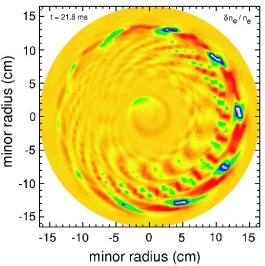CUTIE: Difference between revisions
No edit summary |
No edit summary |
||
| Line 12: | Line 12: | ||
electron and ion temperatures (''T<sub>e</sub>, T<sub>i</sub>''), the ion fluid velocty (''v''), | electron and ion temperatures (''T<sub>e</sub>, T<sub>i</sub>''), the ion fluid velocty (''v''), | ||
the electrostatic potential (Φ) and the parallel vector potential (Ψ). | the electrostatic potential (Φ) and the parallel vector potential (Ψ). | ||
The poloidal magnetic field (and consequently the safety factor, ''q'') evolves in time. | The poloidal magnetic field (and consequently the [[Rotational transform|safety factor]], ''q'') evolves in time. | ||
[[File:CUTIE.jpg|265px|thumb|right|Density fluctuations in a CUTIE simulation (from <ref name="cutie"/>)]] | [[File:CUTIE.jpg|265px|thumb|right|Density fluctuations in a CUTIE simulation (from <ref name="cutie"/>)]] | ||
Revision as of 16:31, 30 July 2010
CUTIE is a quasi-neutral two-fluid computer model for turbulence in a toroidal plasma. [1] [2] [3] [4] The large aspect ratio tokamak ordering is used (R/a >> 1), and Bp << Btor, β << 1. The plasma modelled consists of electrons and a single ion species. Quasi-neutrality (ne ≈ ni) is assumed. The species are locally Maxwellian, but Te ≠ Ti . Particle and energy sources, and a radial profile of Zeff are imposed. Conservation equations for particles, energy, and momentum are solved to obtain the electron density (n), electron and ion temperatures (Te, Ti), the ion fluid velocty (v), the electrostatic potential (Φ) and the parallel vector potential (Ψ). The poloidal magnetic field (and consequently the safety factor, q) evolves in time.

The code solves the evolution on the meso-scale level (larger than the ion gyroradius), co-evolving the flux surface averaged quantities and the turbulence in a self-consistent manner; profile gradients interact non-linearly with the turbulence. Thus, the code is capable of modelling the following fluid-like modes: linear and non-linear shear Alfvén waves, slow magneto-acoustic modes, drift-tearing modes, ballooning modes (ideal and viscoresistive), and the fluid branch of the ion temperature gradient (ITG) instability. The code contains sufficient mechanisms for the generation of sheared flow by turbulence and produces a spontaneous confinement transition similar to the L-H transition in experimental devices.
Code history
Current installations
The code is being used at:
- Culham Centre for Fusion Energy, Culham, UK (code origin)
- Laboratorio Nacional de Fusión, CIEMAT, Madrid, Spain
References
- ↑ A. Thyagaraja, Numerical simulations of tokamak plasma turbulence and internal transport barriers, Plasma Phys. Control. Fusion 42 (2000) B255
- ↑ A. Thyagaraja, P.J. Knight, and N. Loureiro, Mesoscale plasma dynamics, transport barriers and zonal flows: simulations and paradigms, Eur. Journal of Mech. B/Fluids 23 (2004) 475
- ↑ M.R. de Baar, A. Thyagaraja, G.M.D. Hogeweij, P.J. Knight, and E. Min, Global Plasma Turbulence Simulations of q=3 Sawtoothlike Events in the RTP Tokamak, Phys. Rev. Lett. 94 (2005) 035002
- ↑ 4.0 4.1 A. Thyagaraja, P.J. Knight, M.R. de Baar, G.M.D. Hogeweij, and E. Min, Profile-turbulence interactions, magnetohydrodynamic relaxations, and transport in tokamaks, Phys. Plasmas 12 (2005) 090907